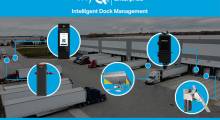Water Heater Innovations is one step closer to achieving that goal in the production of its all-plastic, electric water heaters, thanks to a customized foam roll cradle that speeds the production process, delivers labor and storage savings, and reduces product inventory needs.
Located in Eagan, Minn., Water Heater Innovations manufactures Rheem Marathon all-plastic water heaters, which are popular with electric utilities. Until recently, the company was experiencing a small glitch in its production process that was costing time, space and ultimately money.
“As part of our manufacturing process, we do what is called filament winding, where glass fiber impregnated with a resin is wound around the water heater bladder, or liner,” explains Glen Bayer, a senior manufacturing engineer. “The tanks are then put on hangers and hung in a curing oven in order to create the strength needed to withstand the water pressure.”
Previously, when Water Heater Innovations took the tanks out of the oven, they would stack them on top of each other in preparation for the next step in the process, which is inserting them in the plastic outer jackets and filling the space between jacket and tanks with insulating foam. If the tanks weren’t completely cured when stacked, contact with each other could bind them together. That could cause small indentations or damage when the tanks were separated.
Enter the cradle
The company looked at several solutions, including lengthening the curing time and storing the tanks separately, but neither proved feasible. An online search turned up a a recycled-fiber, foam and plastic roll cradle protection for cylindrical and rolled objects (Rollguard, http://www.rollguard.com).
Noticing the shape similarities between the water heater tanks and some of the cylindrical products that already being cradled, Bayer contacted the company and tested several styles, including an expanded polyethylene cradle they now call a yoke. It keeps the tanks from touching or sticking together.
Bayer estimates that the cradles save about four labor-hours per day that Water Heater Innovations employees previously spent separating the tanks that had become stuck together and moving the tanks around. And, because the cradles are designed to fit on standard-sized pallets, they are freeing up additional space in the factory. With each tank securely nestled in a cradle, they can be safely stacked in a way that uses less floor space than before.
“We used to have to stack them in a log-pile formation on oversized pallets that had to be custom-built,” Bayer says. “The pallets were about twice as long as standard pallets and they had a really heavy roll bar built around them to contain the tanks. The pallets were really bulky and difficult to handle, so we were limited in what we could do with them.
Now, the company stacks two layers of tanks on a standard-sized pallet, but they can go as high as three.
Bayer believes the cradles will also help improve cash flow and inventory control by making his production process leaner. “We are projecting more than a 50% reduction in our finished goods inventory,” he says. “We expect to see a significant improvement in customer service and delivery time.”
Now, nearly a year since first implementing the new cradles, Water Heater Innovations has approximately 300 cradles in use. Most importantly, since Water Heater Innovations began using cradles, the company has not experienced tanks sticking to each other.








